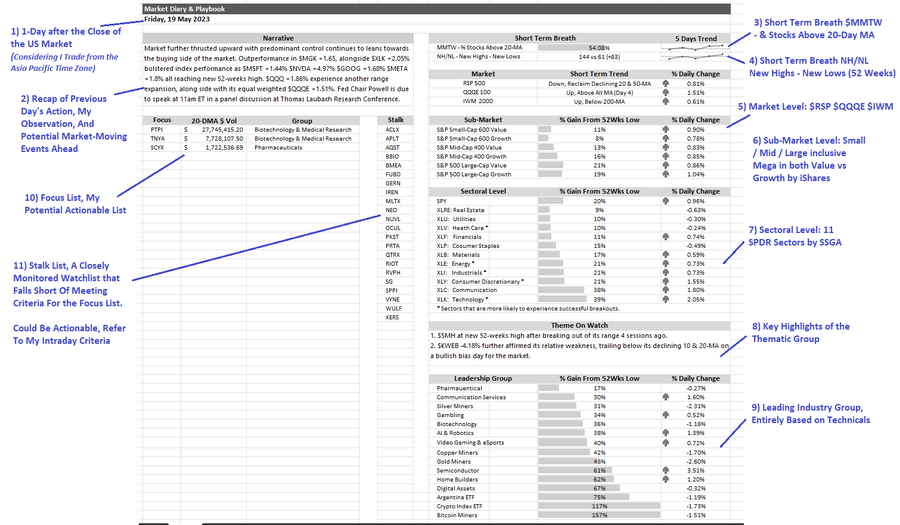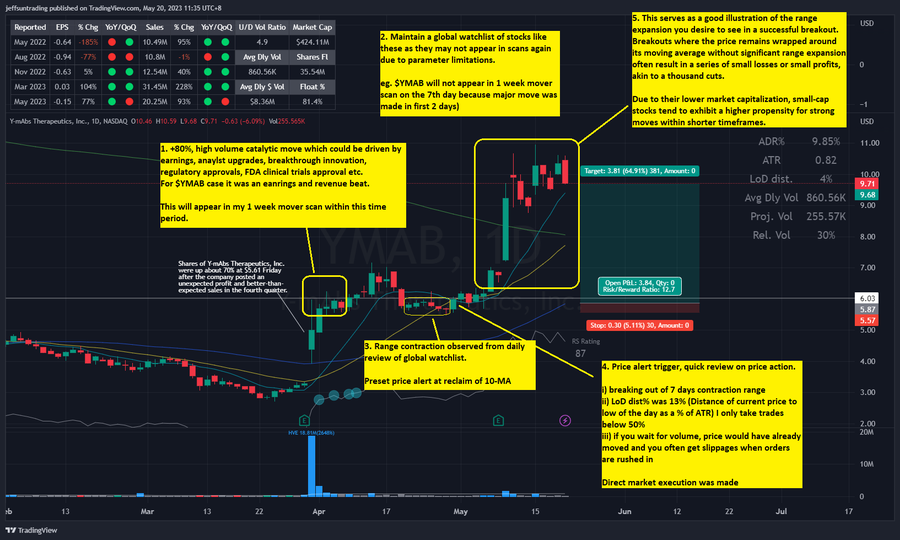
1. Date (Why it is 1-Day after the Market Close) As most of you are aware, I am a Singaporean trader who primarily operates within the Asia Pacific time zone, even when I frequently travel on short-haul flights. It’s worth noting that, like many others, I have regular sleeping patterns even while trading the US market. Therefore, when I wake up, my first task is to prepare my market diary, which includes pre and post-market analysis. However, since I am already in the Asia Pacific region (GMT +8 currently), my diary is typically dated a day later due to the time difference. I strive to maintain my focus and align my travels within a time zone range of +2/-2. This approach allows me to capitalize on the advantage of preparing my pre-market and post-market work when my mind is at its freshest state in the morning. At this stage of my life, I approach trading with utmost seriousness as it plays a crucial role in funding not only my own needs but also those of my two retired separated parents. Additionally, I rely on trading to support the growth of my leveraged real estate portfolio, which currently exceeding 10 million dollars. For those traders based in the Asia time zone who are curious about my approach to managing US trading, below is a response that I frequently copy and paste to address this topic. “ 1. I make it a habit to wake up before 8.30am GMT+8 every day, and ensure that my pre-market tasks are completed before the US market opens at 9.30pm GMT+8. I usually complete them before my lunch. 2. What occupies me after are usually reading, fitness hobbies, youtube
streams, coffee, culinary, and admisntrative for my real estate holding business 3. To ensure that I am well-rested and alert, I make it a point to go to bed before 2.30am GMT+8 every day. Thus, I developed the habit of avoiding executing market orders after the US lunch session. 4. During weekday evenings, I prioritize trading and do not socialize much. It probably been almost a decade since I ever stepped into a pub on a weekday evening. As a trader based in the Asia & (EU timezones previously and during travel), 5. I find it important to maintain relationships, as trading can be a solitary activity. But I am highly motivated to achieve a certain level of net worth before I turn 40 and I have the skill and tools for it. I am currently 35.’ ”
2. Narrative Recap of previous day’s action, my observation, and potential marketing moving events for the day. Most of the market movers at index, sectoral or group level are also captured and easily visualized in the other sections of the diary.
3. Short Term Breath $MMTW (% Of Stocks Above 20-MA) $MMTW is an oscillator that can be utilized as a breath indicator to assess the internal strength and weakness of the underlying index by analyzing the percentage of stocks trading above a 20-MA. I recommend referring to the historical data I extracted in the tweet below to comprehend why I emphasize using a threshold of >50% as an indication of a bullish bias in the overall market, specifically when 10-MA is above 20-MA at index level.
4. Short Term Breath NH/NL (New Highs – New Lows of 52 Weeks Level) The number displays the daily difference between the number of stocks reaching new 52-week highs and the number of stocks reaching new 52-week lows across Nasdaq, NYSE and AMEA. There are various sources you could extract this data but the most comprehensive one would be https://barchart.com/stocks/highs-lows/summary… If you are a TradingView user, you may search for the below 2 indicators of different variation; 1.
– ‘Net New Highs/Lows (with visible code) by Fred6724 2.
– ‘US Markets Net Hew Highs/Lows by CarusoInsights
5. Market Level $RSP $QQQE $IWM 1. $RSP (equal weight of cap weighted $SPY) 2. $QQQE (equal weight of cap weighted $QQQ) -Equal weighted representation means that each stock within the index carries the same weight. This provides a more balance representation of the overall market performance compared to the capitalization weighted counterpart, and thus a more comprehensive overview of market trend. -2023 has been a great illustration how cap-weighted $SPY and $QQQ has been skew to the overall market analysis as the rally in those indexes has been towards a few dominantly mega cap players. -The weakness in ratio of $RSP/$SPY, $QQQE/$QQQ, which reflects the relative weakness of the numerator, which in this case are $RSP and $QQQE, allows potential early detection of weakness as the equal-weighted index could give earlier indications of broader market trends. 3. $IWM (cap weighted but 2000 stocks) $IWM offers several benefits in market analysis. -Direct analysis of performance and trends from a diverse range of smaller companies across various sectors and industries, which may differs from broader market represented by $SPY $QQQ -Small-cap stocks are generally more sensitive to changes in the domestic economy than large-cap stocks. As a result, $IWM can serve as a leading index to $SPY and $QQQ
6. Sub-Market Level I utilize the breakdown provided by
, consisting of $IJS, $IJT, $IJJ, $IJK, $IVE, and $IVW, primarily to assess outperformance and underperformance based on daily % changes. This breakdown forms part of my framework for conducting deeper analysis of market cap adjustments in my daily scans, whenever necessary.
7. Sectoral Level Comparing the strength of the 11 SPDR sectors offered by
can be done by assessing the percentage gain from their respective 52-week lows. This is in simplciity of course, as ADR& of each sector is not taken into account. eg. $XLE is trading at ADR% of 2.09% vs $XLP at ADR% of 0.84%, more than doubling its volatility. Conversely, analyzing the percentage loss from their 52-week highs would provide a comparison of weakness. There are 5 particular sectors that hold a prominent position in my watchlist, indicated by an asterisk (*). For a clearer understanding, I invite you to refer to the recent thread I created on this topic.
8. Theme On Watch I take pride in my narrative and observations regarding the key movers and highlights of thematic groups. Notably, I am pleased with my call for $KWEB relative strength back in November, the breakdown in $KBE and $KRE in early March, and the recent rally in $SMH before 12th May
and the Global Industry Classification Standard (GICS) offered by
and
. Another approach I employ is based on available ETFs that are tradable in the market.
10. Focus List (Part 1) Before we proceed, I kindly request you to refer to the link below for the configuration of my charting template and the indicators that I find particularly valuable. https://twitter.com/jeffsuntrading/status/1649336864556589058… i) Setups & Execution Primarily, my trading revolves around setups involving range breakouts of high momentum stocks. To delve deeper into this strategy, I aim to enter trades before the range expands following a period of contraction. I specifically look for stocks that have recently shown accumulation, and my main scans typically focus on significant percentage gains over various timeframes such as 1 week, 1 month, 3 months, and 6 months. in $YMAB trade, the following fulfills my criteria when it appeared in my scan i) Strong catalytic move with high volume. Many notable breakouts on their second leg of the rally often stem from a price + volume disrupted rally within stage 4 bases. ii) High ADR% equate to momentum is in place, and could often mean stronger price expansion moves are just ahead iii) Strong RS iv) Volume Dry Up (not definite criteria in my case) v) Price contraction above above short term moving averages (10 & 20-MA primarily) refer to the image below for illustration of $YMAB, along with Execution This was another discussion early in the week before $BLPH broke out +20% on a 1 day move
10. Focus List (Part 2) ii) Watchlist Management Prior to delving into the parameters of my scans, I cannot stress enough the significance of maintaining a comprehensive global watchlist that fulfills criteria but not ripe for action. It is crucial to understand that many actionable stocks that presents lucrative opportunities often emerge a few days or weeks in the scans, rather than on the very day of scanning. If you come across a stock that appears promising but is not yet fully prepared (for instance, lacking price contraction or requiring moving averages to catch up as price undergoes a softening action), it is essential to include it in your global watchlist and diligently monitor it on a daily basis. As I highlighted in the trade below, $YMAB will not appear in a 1 week mover scan on the week it moved. To provide some context, as of now, I have a global watchlist consisting of 142 stocks. I meticulously review this list every day, adding new promising stocks that emerge from my scans and removing any with disrupted price action. Additionally, I also go through over 50+ leveraged ETFs on a daily basis, as they play a significant role in my trading strategy. Trading leveraged ETFs has proven to be a reliable and consistent approach for me. It serves as my bread and butter in the market. Some of my biggest RRR trade are from this segment of the market in the past 6 months, making up for the higher losing rate.

10. Focus List (Part 3) iii) Scans – Finviz Free Version I strongly advocate for utilizing the free tools available on the internet for those who are still striving to become proficient in trading. Trading itself carries significant costs and unforeseen events that can disrupt your equity curve, some of which you may not even be aware of. These include factors such as wide spreads, execution slippages, and locate fees, among others. By leveraging the free tools provided online, you can mitigate some of these costs and gain a deeper understanding of the trading landscape. In my opinion, a good precise strong mover scan should yield less than 60 results. You want the top quality movers. Below is the direct link to the Finviz version of my scans. You can make amendment to include any of your preferred criteria to only streamline the scan, not expand it. 1. 1-Week Mover Exceeding 20% – https://finviz.com/screener.ashx?v=111&f=cap_smallover,sh_avgvol_o300,sh_curvol_o100,ta_perf_1w20o,ta_volatility_wo4&ft=4&o=-marketcap… 2. 1-Month Mover Exceeding 30% – https://finviz.com/screener.ashx?v=111&f=cap_smallover,sh_avgvol_o300,sh_curvol_o100,ta_perf_4w30o,ta_volatility_mo5&ft=4&o=-marketcap… 3. 1-Month Mover Exceeding 50% (I would toggle to this scan instead if there are too many results appearing in ‘1-Month Mover Exceeding 30%’ due to strong market. The whole idea is to look for the strongest mover of each time period – https://finviz.com/screener.ashx?v=111&f=cap_smallover,sh_avgvol_o300,sh_curvol_o100,ta_perf_4w50o,ta_volatility_mo5&ft=4&o=-marketcap… 4. 3-Month Mover Exceeding 50% –https://finviz.com/screener.ashx?v=111&f=cap_smallover,sh_avgvol_o300,sh_curvol_o100,ta_perf_13w50o,ta_volatility_mo5&ft=4&o=-marketcap… 5. 6-Month Mover Exceeding 100% – https://finviz.com/screener.ashx?v=111&f=cap_smallover,sh_avgvol_o300,sh_curvol_o100,ta_perf_26w100o,ta_volatility_mo5&ft=4&o=-marketcap
10. Focus List (Part 4) iv) Scans –
Free Version Below is a Screenshot for parameters of Scan for ‘1-Week Mover Exceeding 20%’ on
You can do the same adjustment based on the filters from Finviz for each scans on
Although the parameters for the five scans in Finviz are largely the same, it is interesting to note that some names may not appear on both platforms. If you are proactive, I highly recommend conducting the scans in both platforms.
11. Stalk List So in my earlier post, I highlighted on my global watchlist consisting of 142 stocks (at the point of writing) which I meticulously review this list every day, adding new promising stocks that emerge from my scans and removing any with disrupted price action. From reviewing this 142 stocks in my global watchlist, I further pick out stocks that are building their short term bases but remains early for substantial moves in my opinion. This could be due to the following; i) Upcoming earnings. I typically avoid trading stocks with upcoming earnings within the next five days. However, I am willing to consider trades with an earnings leeway of six days or more. This could either give me substantial profit cushion into earnings, or sufficient allowance for pre earnings day exit. ii) Price softening, but remains loose and seeking more price tightening. Range contraction in Focus List remember? iii) 10, 20-MA have not yet catch up the softening price action iv) Running into Declining Major MA (Specifically 200-MA), many of such breakout trades beneath an approaching declining 200-MA failed miserably in history, especially this year. If there’s at least a 3xADR& distance in the build up, I will still upgrade them to Focus List. iv) Below 10, 20-MA but trailing it closely. $APLT in the chart below is a great illustration. $1.59 price alert for recapturing above 10-MA. I want to stress that there is a chance of trading the stocks mentioned in my Stalk section on the same day. This typically happens when a stock gaps up from its previous close, presenting an advantageous entry opportunity as the price has already exceeded the breakout level of a range but remaining tight from it’s % LoD dist. While I may not strictly adhere to all the criteria in such cases, you can be certain I will make any execution that allow me to enter at extremely high lucrative risk reward based on LoD distance % beyond pivot.
12. I have reached the conclusion to give you an overview of how I maintain a daily market diary, and I hope you recognize the significance it holds in your development and growth as a trader from the process of doing it. This diary serves as a valuable navigational tool, keeping you closely aligned with market movements, enhancing your situational awareness, and helping to prevent excessive trading outside of your prepared watchlist. Having shared all the insights, I eagerly anticipate your future engagement with my Market Diary postings. I invite you to join the discussion, where we can exchange ideas, provide commentary, and even respectfully disagree based on our individual analyses of different market levels. As a perpetual learner in the market, I greatly value intellectually stimulating discussions and welcome the opportunity to engage in such conversations with you.
